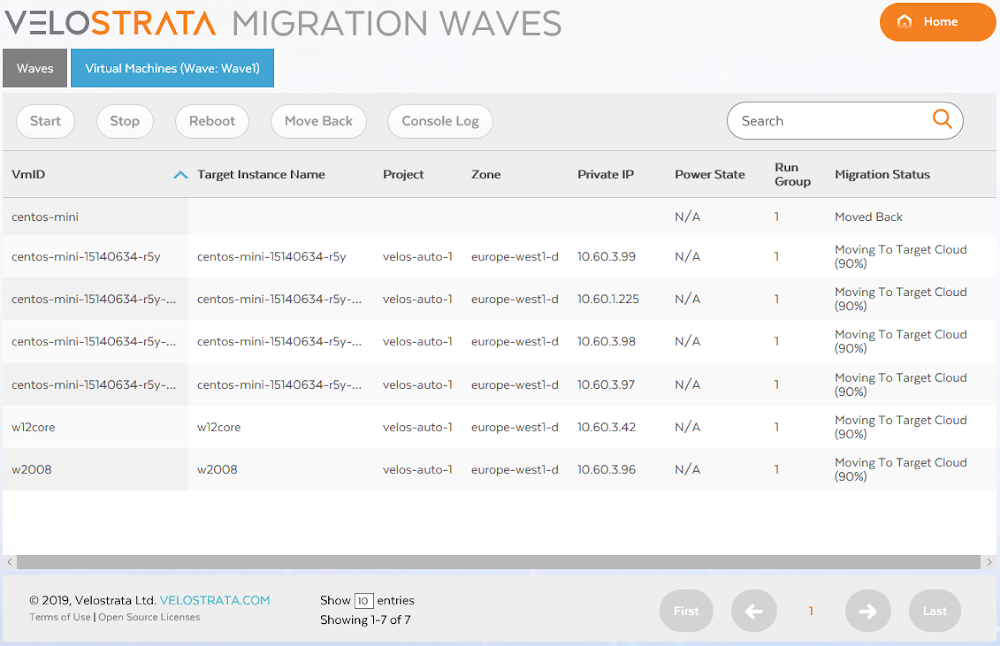Enterprise cloud migration projects often include moving hundreds or thousands of application workloads from on-prem or other clouds into Google Cloud Platform (GCP). Migrating the entirety of your data center at once is challenging, if not impossible. The best practice we’ve seen is to assess your workloads and batch them into different migration groups based on factors like their production level, inter-application affinity and collaboration, size, importance to the business, performance needs, and more. To do that, it’s crucial to have a high-level view of the entire migration project, in addition to granular views and controls over when and how these batches are migrated.That’s why we’ve introduced migration waves in the latest release of Velostrata, GCP’s real-time enterprise migration tool. A migration wave is a way of organizing the systems you want to move into batches that make your migration strategy more manageable. Migration waves give you vantage points and controls to plan, execute, and monitor your migration to GCP at each step of the journey. You can see here what migration waves look like:Velostrata’s new user interface for migration wavesUsing migration waves makes the cloud migration process simpler. For example, you may choose to migrate all of the VMs in your data center that are associated with dev/test first, so you create a wave with the first 25 VMs, then another 25 VMs, and so on until your dev/test landscape is successfully in the cloud.In addition to that, with migration waves you are able to:Plan and prioritize specific groups of systems in the migration plan for a holistic view of how the project will proceed over time, while broken down into smaller, logical waves.Pre-validate migration waves to ensure that your VM and GCP configurations are correct before you begin migrating.Perform migration operations as needed on any given wave, giving you the power to control their pace and progress. For example, you can launch test instances in GCP for a particular migration wave and confirm that performance and SLAs are met before you migrate. Another example: with migration waves, you can perform dynamic instance right-sizing to optimize the post-migration cloud costs. You can perform as many operations as desired on any given wave.Monitor the progress of any wave operation down to each specific system in that wave. If something unplanned occurs, like a particular VM fails to migrate, you can restart the operation, but Velostrata will intelligently re-run it only on the systems needed. This gives you peace of mind that the systems that migrated successfully won’t be impacted by unexpected errors.Review historical migration wave logs and records any time, giving you an easy way to track and analyze progress against timelines and milestones.In addition to migration waves, Velostrata now includes other new capabilities that give you a smoother, faster path to GCP. These include:Velostrata can now be deployed directly using Google Click to Deploy, making it available to anyone with just a few clicks.We’ve right-sized support for instances migrating from Amazon EC2 to Google Compute Engine, helping you maintain cloud costs without accidentally over-provisioning. This complements the right-sizing support we’ve been offering for VMs migrating from VMware on-prem.Conversion to pay-as-you-go licenses: There is now an option for automatic conversion of existing (on-prem) Enterprise Linux licenses to GCP pay-as-you-go premium licenses. This makes it easier for you to reduce your license costs and management after you migrate, without having to rebuild your virtual machines.Along with all the new capabilities, we’re also thrilled to relay that all of the documentation forVelostrata 4.0 is officially a part of the GCP family, following our 2018 acquisition. You can also find support information for Velostrata here.If you’d like more information on cloud migration to GCP, get Velostrata details here or contact us for more information.
Quelle: Google Cloud Platform

Published by